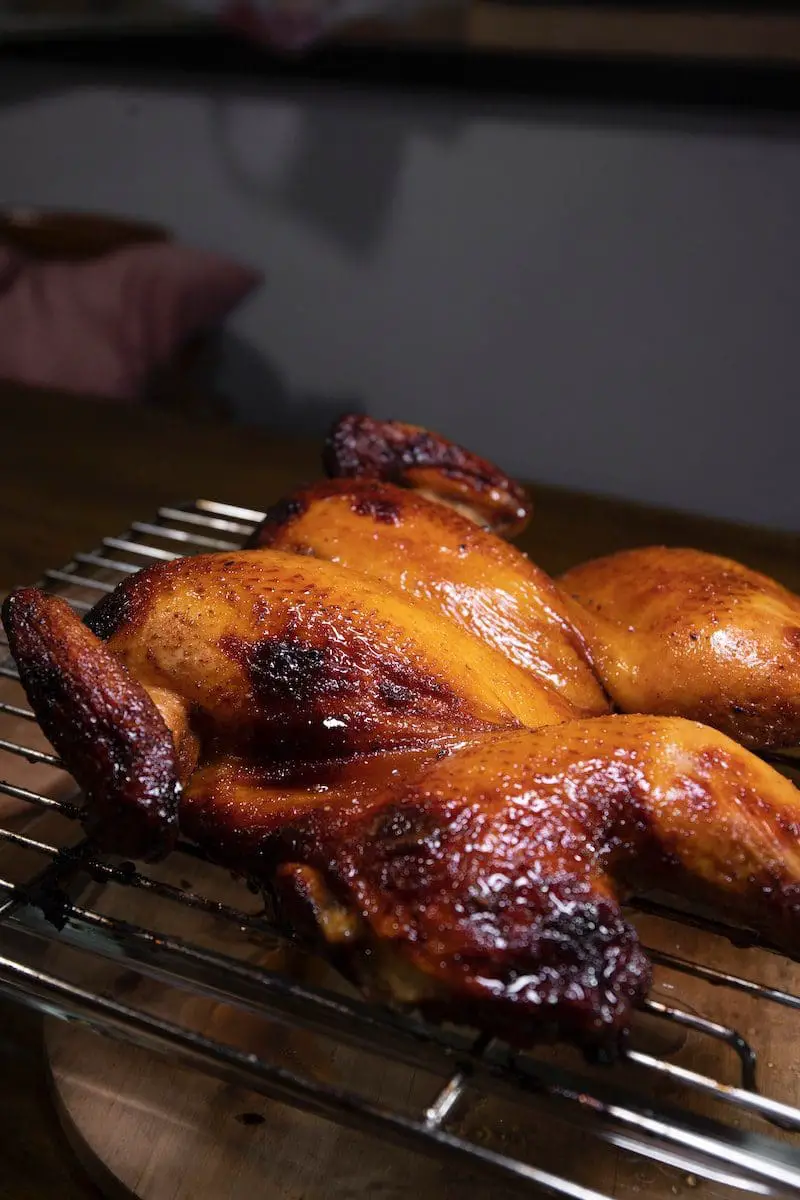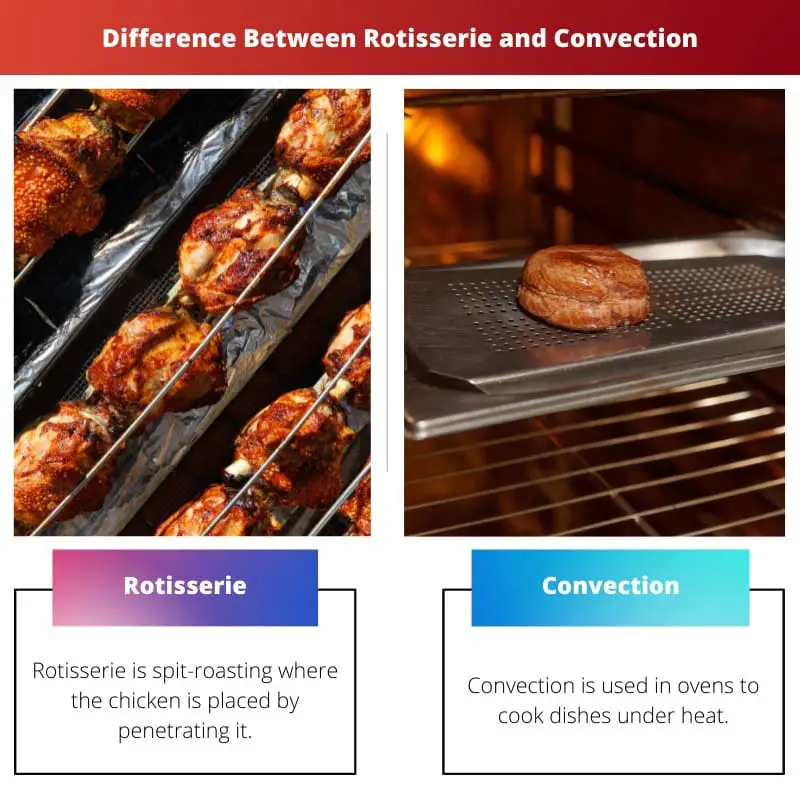Ovens are a new and modern way of cooking and warming up cold and frozen dishes. The cooking hardware and technology have saved ample time, and several services we can choose from.
Microwave ovens using convection mode for cooking and rotisseries are some of the best methods of cooking chicken and other meat or vegetarian dishes with Various unique and different options. But they’re not the same, of course.
Key Takeaways
- Rotisserie is a method of cooking meat by rotating it on a spit over a heat source, whereas convection is a cooking technique that uses hot air to circulate heat evenly around the food.
- Rotisserie is ideal for cooking large cuts of meat such as chicken, beef, and pork, while convection is suitable for baking, roasting, and broiling.
- Rotisserie cooking results in crispy skin and juicy meat, while convection cooking results in even browning and faster cooking times.
Rotisserie vs Convection
The difference between rotisserie and convection is that the rotisserie method is known as spit-roasting. To be precise, the dish meat is skewered on the spot with a long solid rod holding the chicken horizontally. In contrast, the convection mode is used in ovens where the dish is heated and baked under the influence of heat hitting the dish from every corner of the oven.

Rotisserie is one of the major instruments or cooking hardware that are used for cooking or roasting chickens while penetrating it through the horizontal rod placed over the coal section.
Well, it’s also known as spit-roasting, where the rod holds food and rotates so that every marinated corner gets heat. Convection is under the influence of heat when a dish is placed inside the microwave oven. It’s one of the most used methods to dry cook a meal.
Several brands like LG and IFB are stainless steel convection microwave ovens that allow you to customise the temperature with the help of buttons embedded in the oven. There’s an LED and a transparent glass to see the dish cooked under the heat coming out from all four walls.
Comparison Table
| Parameters of Comparison | Rotisserie | Convection |
|---|---|---|
| Definition | Rotisserie is spit-roasting where the chicken is placed by penetrating it. | Convection is used in ovens to cook dishes under heat. |
| Mechanism | Rotisserie has a rod that holds the chicken to be baked properly. | Convection ovens don’t have a rod. Instead, they have a glass plate inside that acts as a base to keep your dish on. |
| Rotation | The rotisserie rotates vertically since the rod is placed horizontally. | The Convection ovens rotate as a disc rotates inside the CD player. |
| Scalability | Rotisserie is mostly used for cooking meat. | Convection ovens are general and can be used to cook anything. |
| Safety option | Rotisserie isn’t much good and a safer one since it’s an open heat cooking. | Convection ovens are safer since these Cook meals inside the oven. |
What is Rotisserie?
Well, modern days are here, and all you can see is life getting simpler and assets getting handy day by day. Indeed science and technology have taken a good and positive fold towards the welfare of the world. From firewood used for cooking to gas systems and now ovens, life’s getting sorted every day.
Well, it’s no news that the Rotisserie is one of the major instruments or cooking hardware that is used for cooking sumptuous and delicious food. The mechanism seems quite easy. However, it’s tricky. It’s like a table with a rod attached to the base, allowing the meat to hang on.
The meat is skewered on a spit and also known as spit-roasting. A long rod is used which holds the chicken that is baked over a fire. These are used in campfires of a fireplace where cutlery’s scarce.
Well, restaurants have also adopted this mode to make sure the customers seek the best food and taste. These are used for cooking a large portion of meat. For example, a whole chicken or a lamb can be baked in a go by Rotisserie.
The rotation cooks the meat evenly since it’s rotated manually, allowing easy access for continuous basting.

What is Convection?
Today’s World is full of science. From automatic vehicles to sensors on the counters, the developers have been able to simplify life by saving enough time. On the other hand, ovens were invented to save much of the time, reducing the cost and the need for labour.
Convection ovens are used for cooking, baking, or warming up cold food. These Convection ovens have a cuboidal shape with different sizes and capacities. These use heat for cooking meals. It has a door that allows the chef to put his dish in and close the lid.
The lid is transparent and allows the dish to be observed from the outside. These Convection ovens have buttons to manipulate the dish and bake it according to the requirement.
Convection ovens throw heat at the dish placed inside the oven and rotate the fish vertically. There’s a glass base where you can put your dish on. These also have an exhaust fan to maintain the temperature of the oven and prevent overheating.
Since these come in different sizes and volumes, a slice of whole meat can’t be baked properly. The advantage of convection ovens is that these exhaust fans remove the moisture that allows proper heating of food and maintains the crispiness and juice of the food.

Main Differences Between Rotisserie and Convection
- Rotisserie uses the rod to cook meat or chicken, while convection uses the oven to cook dishes.
- Rotisserie is a spit roasting method, while convection is a heating the food method.
- Rotisserie is widely used for cooking whole meat, while convection can also be used to cook vegetarian foods.
- Rotisserie cooks the dish in the open, while the convection method cooks the food in a closed manner.
- In Rotisserie, the rod is placed horizontally and rotating vertically while there’s a base that rotates like a disc with a dish over it.

- https://digitalscholarship.unlv.edu/grrj/vol9/iss1/3/
- https://www.tandfonline.com/doi/abs/10.1080/09523367.2021.1876674





These are insightful comparisons between rotisserie and convection cooking methods. It’s fascinating how each method has its unique benefits for cooking different types of food.
This article provides a clear explanation of how rotisserie and convection work and the types of dishes that are best suited for each method. It’s a great read for food enthusiasts.
I agree, the information provided here is very helpful for anyone who wants to understand the differences between rotisserie and convection cooking.
The detailed explanations of rotisserie and convection cooking provide valuable insights into how these methods work and their applications. It’s a well-researched and informative article.
The article’s detailed explanations of rotisserie and convection cooking are insightful and well-presented. It provides a comprehensive understanding of these cooking methods.
The article’s comprehensive analysis of rotisserie and convection cooking is very informative. It offers a detailed understanding of the benefits and uses of each method.
The comparison of rotisserie and convection cooking is well-explained and offers valuable insights into their mechanisms and uses. It’s a compelling resource for culinary enthusiasts.
I found the article’s comparison of rotisserie and convection cooking very informative. The detailed breakdown of their mechanisms and benefits is impressive.
The article’s in-depth analysis of rotisserie and convection cooking methods is highly informative. It provides a clear understanding of the unique benefits of each method.
The historical and modern aspects of rotisserie and convection cooking are presented in a well-organized manner. The article offers a comprehensive analysis of these cooking methods.
I appreciate the article’s comprehensive coverage of rotisserie and convection cooking methods, including their historical and modern contexts. It’s a well-researched piece.
The detailed historical and modern perspectives on rotisserie and convection cooking make the article a valuable resource for food enthusiasts.
The comparison table is particularly helpful in understanding the differences between rotisserie and convection cooking. It’s great to have a clear breakdown of their mechanisms and uses.
I appreciate the detailed comparison table that outlines the mechanisms and safety options of both cooking methods. It’s a valuable resource for those interested in cooking.
The detailed descriptions of rotisserie and convection cooking are impressive. The article provides valuable insights into the advantages and best uses of each method.
The article’s comparison of rotisserie and convection cooking is well-researched and informative. It’s a great resource for those interested in culinary arts.
I agree, the article effectively highlights the unique benefits and uses of rotisserie and convection cooking. It’s a comprehensive guide to different cooking techniques.
The article’s detailed comparison of rotisserie and convection cooking methods is highly informative and well-researched. It’s a compelling read for anyone interested in culinary arts.
The historical and technological perspectives on rotisserie and convection cooking are well-documented in the article. It provides an enriching overview of these methods.
I appreciate the comprehensive coverage of rotisserie and convection cooking, including historical and technological insights. It’s a valuable resource for any food enthusiast.
The explanation of how rotisserie and convection methods work is very informative. It’s interesting to learn about the historical background of these cooking techniques as well.
I found the historical context of rotisserie and convection cooking fascinating. It’s great to understand the evolution of cooking methods over time.
The article provides a thorough understanding of the differences between rotisserie and convection cooking. The detailed explanations of each method are very insightful.
The information provided about rotisserie and convection cooking is well-researched and presented in an easy-to-understand manner. It’s a great read for cooking enthusiasts.
I found the article’s explanations of rotisserie and convection cooking very detailed and educational. It’s a valuable resource for anyone interested in cooking.